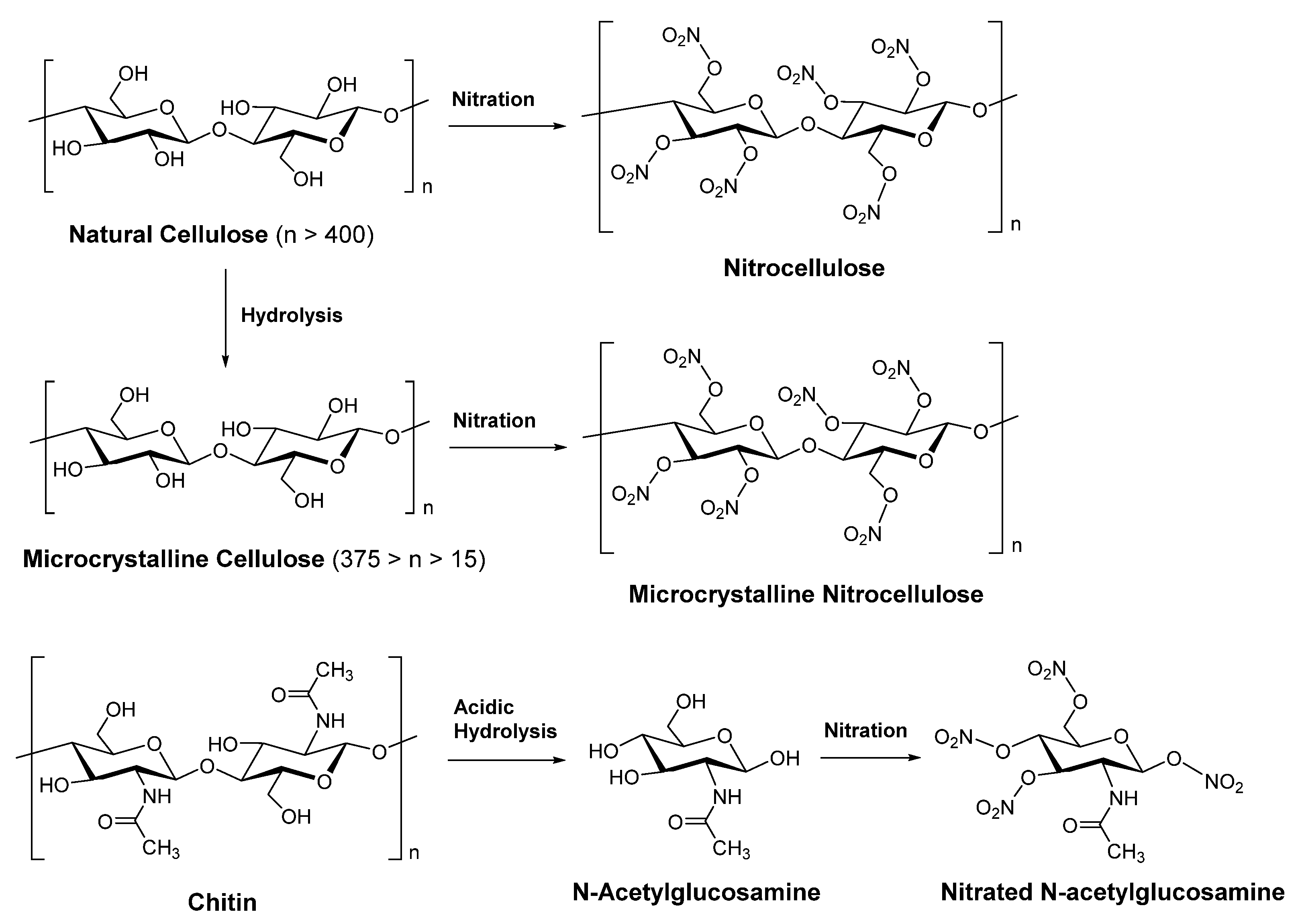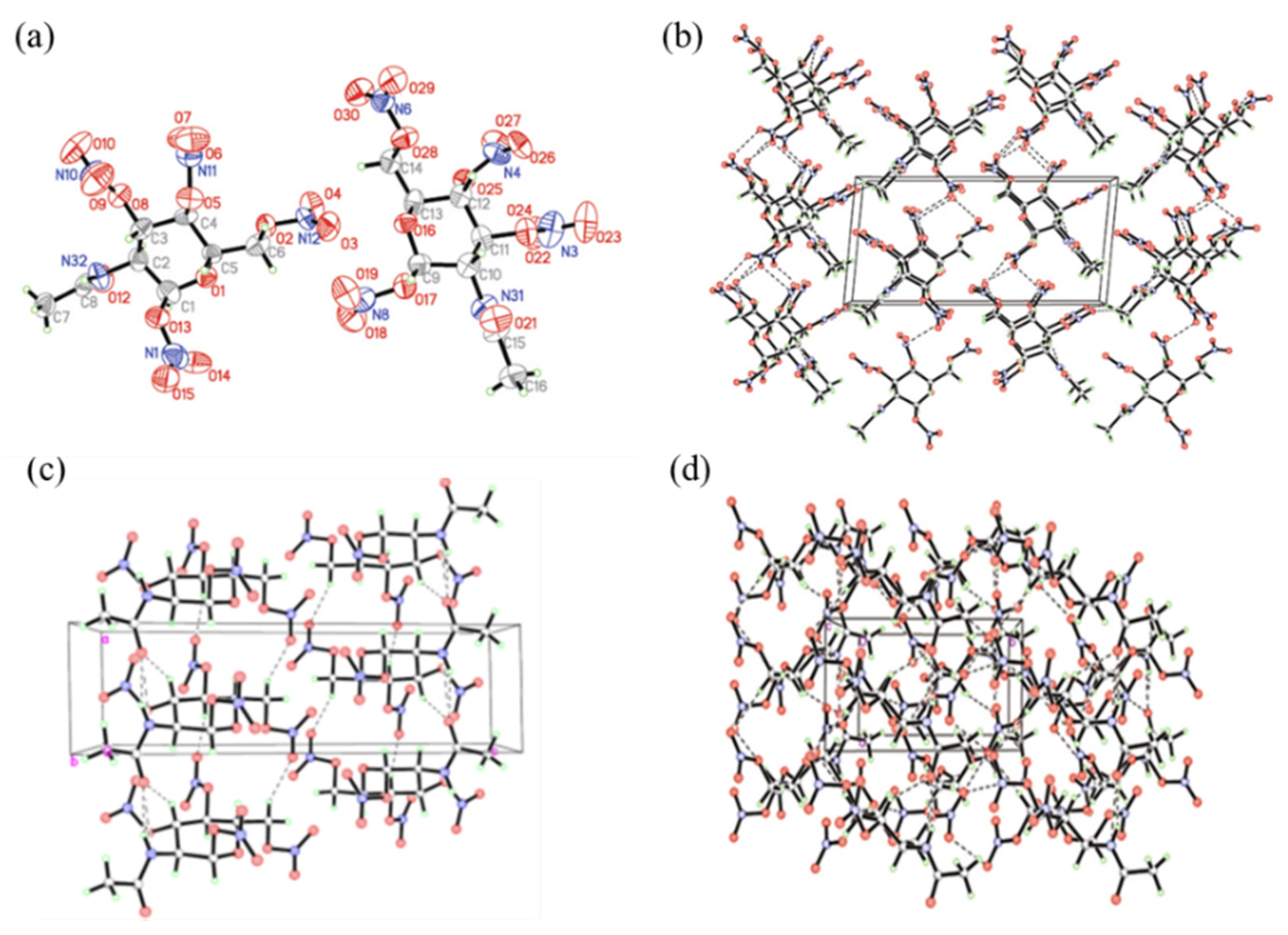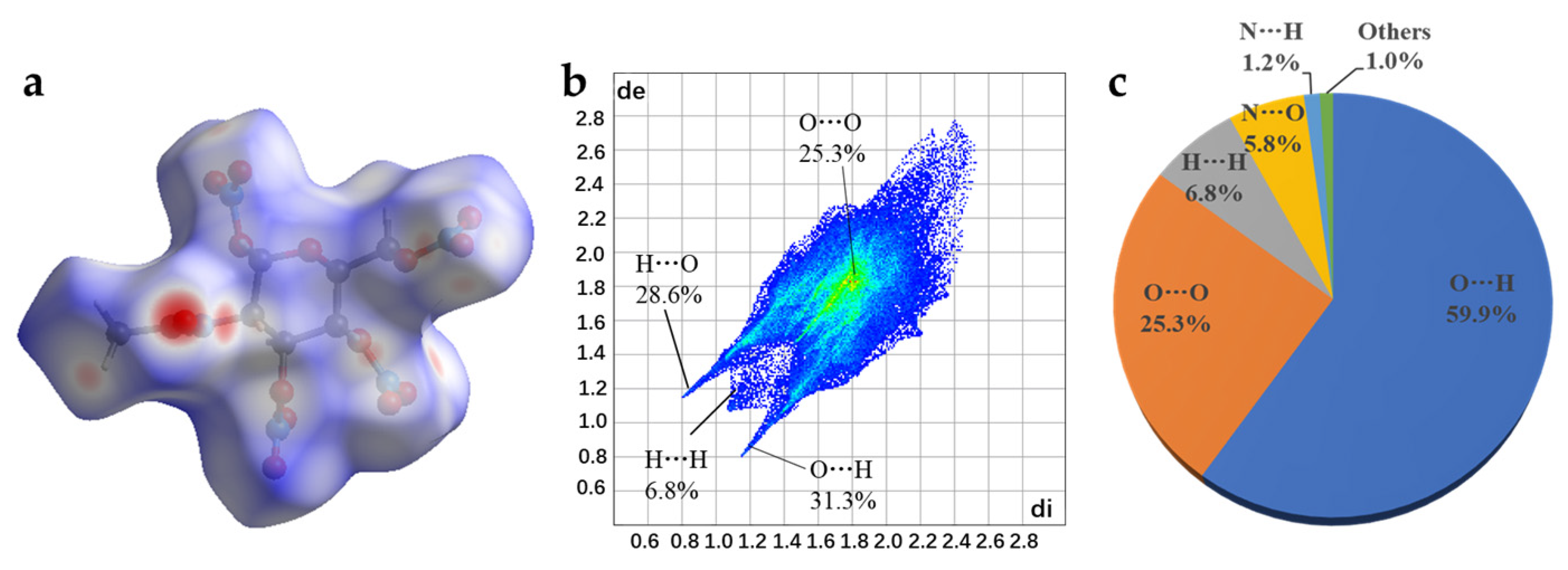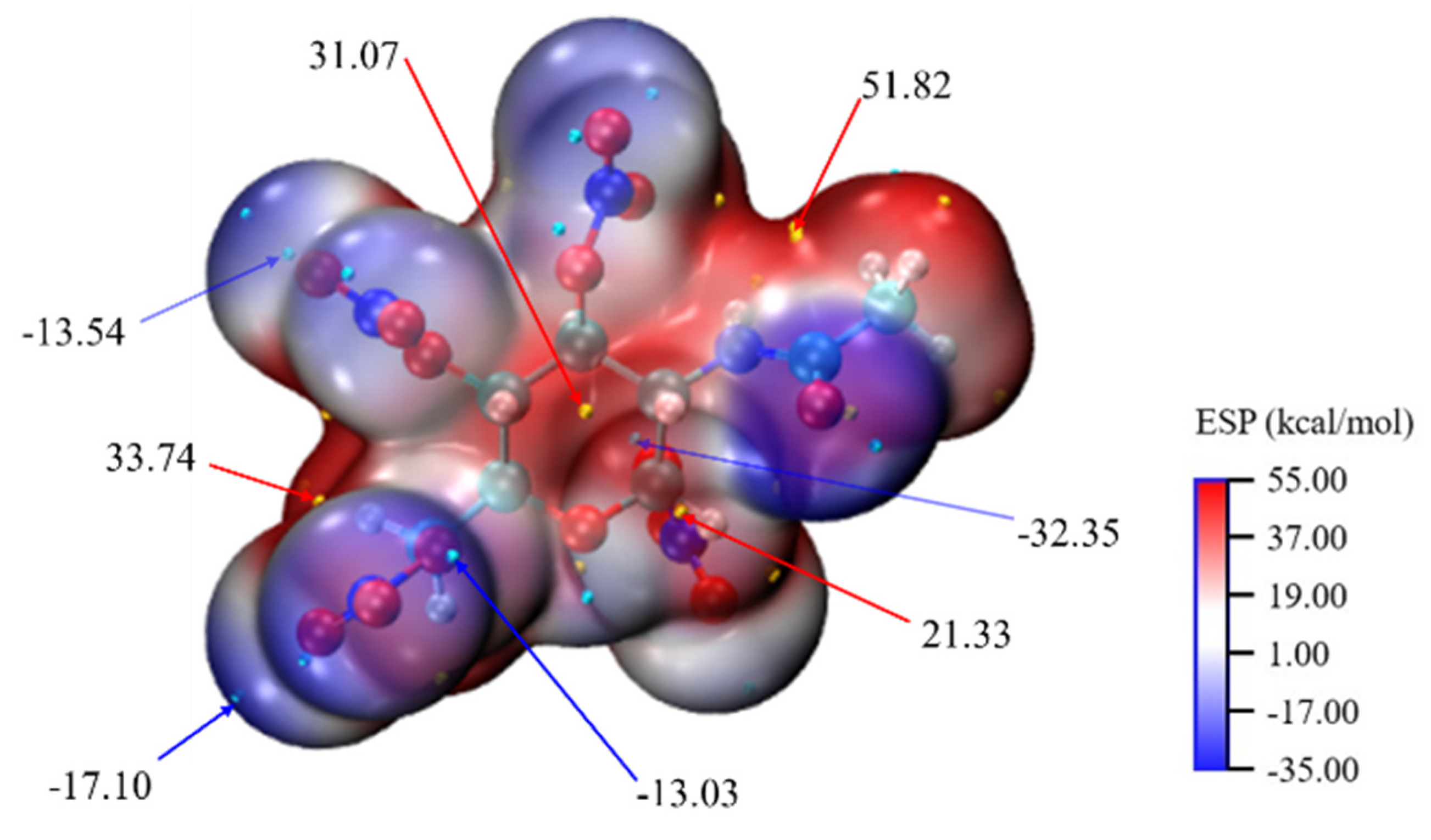Nitration of Chitin Monomer: From Glucosamine to Energetic Compound
Abstract
:1. Introduction
2. Results and Discussion
2.1. Synthesis
2.2. Single-Crystal X-ray Analysis
3. Physicochemical and Energetic Properties
3.1. Density and Heat of Formation
3.2. Detonation Performance
3.3. Hirshfeld Surface
3.4. Thermal Stability and Mechanical Sensitivity
3.5. Electrostatic Potential
4. Experimental Section
4.1. General Information
4.2. Synthesis of Compound 1
5. Conclusions
Supplementary Materials
Author Contributions
Funding
Institutional Review Board Statement
Informed Consent Statement
Data Availability Statement
Acknowledgments
Conflicts of Interest
Sample Availability
References
- Berglund, L.A.; Burgert, I. Bioinspired Wood Nanotechnology for Functional Materials. Adv. Mater. 2018, 30, 1704285. [Google Scholar] [CrossRef]
- Kuchurov, I.V.; Zharkov, M.N.; Fershtat, L.L.; Makhova, N.N.; Zlotin, S.G. Prospective Symbiosis of Green Chemistry and Energetic Materials. ChemSusChem 2017, 10, 3914–3946. [Google Scholar] [CrossRef]
- Tarchoun, A.F.; Trache, D.; Klapötke, T.M.; Krumm, B.; Khimeche, K.; Mezroua, A. A promising energetic biopolymer based on azide-functionalized microcrystalline cellulose: Synthesis and characterization. Carbohydr. Polym. 2020, 249, 116820. [Google Scholar] [CrossRef]
- Tanpichai, S.; Biswas, S.K.; Witayakran, S.; Yano, H. Water Hyacinth: A Sustainable Lignin-Poor Cellulose Source for the Production of Cellulose Nanofibers. ACS Sustain. Chem. Eng. 2019, 7, 18884–18893. [Google Scholar] [CrossRef]
- Tarchoun, A.F.; Trache, D.; Klapötke, T.M.; Krumm, B. New insensitive nitrogen-rich energetic polymers based on amino-functionalized cellulose and microcrystalline cellulose: Synthesis and characterization. Fuel 2020, 277, 118258. [Google Scholar] [CrossRef]
- Tsurkan, M.V.; Voronkina, A.; Khrunyk, Y.; Wysokowski, M.; Petrenko, I.; Ehrlich, H. Progress in chitin analytics. Carbohydr. Polym. 2021, 252, 117204. [Google Scholar] [CrossRef] [PubMed]
- Crini, G. Historical review on chitin and chitosan biopolymers. Environ. Chem. Lett. 2019, 17, 1623–1643. [Google Scholar] [CrossRef]
- Tran, T.H.; Nguyen, H.L.; Hwang, D.S.; Lee, J.Y.; Cha, H.G.; Koo, J.M.; Hwang, S.Y.; Park, J.; Oh, D.X. Five different chitin nanomaterials from identical source with different advantageous functions and performances. Carbohydr. Polym. 2019, 205, 392–400. [Google Scholar] [CrossRef] [PubMed]
- Marzieh, M.N.; Zahra, F.; Tahereh, E.; Sara, K.N. Comparison of the physicochemical and structural characteristics of enzymatic produced chitin and commercial chitin. Int. J. Biol. Macromol. 2019, 139, 270–276. [Google Scholar] [CrossRef] [PubMed]
- Shamshina, J.L.; Berton, P.; Rogers, R.D. Advances in Functional Chitin Materials: A Review. ACS Sustain. Chem. Eng. 2019, 7, 6444–6457. [Google Scholar] [CrossRef]
- Abo Elsoud, M.M.; El Kady, E.M. Current trends in fungal biosynthesis of chitin and chitosan. Bull. Natl. Res. Cent. 2019, 43, 59. [Google Scholar] [CrossRef] [Green Version]
- Jin, T.; Liu, T.; Lam, E.; Moores, A. Chitin and chitosan on the nanoscale. Nanoscale Horiz. 2021, 6, 505–542. [Google Scholar] [CrossRef] [PubMed]
- Tao, F.; Cheng, Y.; Shi, X.; Zheng, H.; Du, Y.; Xiang, W.; Deng, H. Applications of chitin and chitosan nanofibers in bone regenerative engineering. Carbohydr. Polym. 2020, 230, 115658. [Google Scholar] [CrossRef] [PubMed]
- Patel, M.; Schwendemann, D.; Spigno, G.; Geng, S.; Berglund, L.; Oksman, K. Functional Nanocomposite Films of Poly (Lactic Acid) with Well-Dispersed Chitin Nanocrystals Achieved Using a Dispersing Agent and Liquid-Assisted Extrusion Process. Molecules 2021, 26, 4557. [Google Scholar] [CrossRef] [PubMed]
- Satitsri, S.; Muanprasat, C. Chitin and Chitosan Derivatives as Biomaterial Resources for Biological and Biomedical Applications. Molecules 2020, 25, 5961. [Google Scholar] [CrossRef] [PubMed]
- Margoutidis, G.; Parsons, V.H.; Bottaro, C.S.; Yan, N.; Kerton, F.M. Mechanochemical Amorphization of α-Chitin and Conversion into Oligomers of N-Acetyl-d-glucosamine. ACS Sustain. Chem. Eng. 2018, 6, 1662–1669. [Google Scholar] [CrossRef]
- Chen, J.K.; Shen, C.R.; Liu, C.L. N-acetylglucosamine: Production and applications. Mar. Drugs 2010, 8, 2493–2516. [Google Scholar] [CrossRef] [PubMed] [Green Version]
- Baysal, O.; Abdul Ghafoor, N.; Silme, R.S.; Ignatov, A.N.; Kniazeva, V. Molecular dynamics analysis of N-acetyl-D-glucosamine against specific SARS-CoV-2’s pathogenicity factors. PLoS ONE 2021, 16, e0252571. [Google Scholar] [CrossRef]
- Zhang, A.; Wei, G.; Mo, X.; Zhou, N.; Chen, K.; Ouyang, P. Enzymatic hydrolysis of chitin pretreated by bacterial fermentation to obtain pure N-acetyl-d-glucosamine. Green Chem. 2018, 20, 2320–2327. [Google Scholar] [CrossRef]
- Wang, M.; Chan EW, C.; Yang, C.; Chen, K.; So, P.K.; Chen, S. N-Acetyl-D-Glucosamine Acts as Adjuvant that Re-Sensitizes Starvation-Induced Antibiotic-Tolerant Population of E. Coli to beta-Lactam. iScience 2020, 23, 101740. [Google Scholar] [CrossRef]
- Li, J.; Yin, X.; Liu, Z.; Gu, Z.; Niu, J. Reaction yield model of nitrocellulose alkaline hydrolysis. J. Hazard. Mater. 2019, 371, 603–608. [Google Scholar] [CrossRef] [PubMed]
- Sun, S.; Feng, S.; Ji, C.; Shi, M.; He, X.; Xu, F.; Lu, T.J. Microstructural effects on permeability of Nitrocellulose membranes for biomedical applications. J. Membr. Sci. 2020, 595, 117502. [Google Scholar] [CrossRef]
- Secor, E.B.; Gao, T.Z.; Islam, A.E.; Rao, R.; Wallace, S.G.; Zhu, J.; Putz, K.W.; Maruyama, B.; Hersam, M.C. Enhanced Conductivity, Adhesion, and Environmental Stability of Printed Graphene Inks with Nitrocellulose. Chem. Mater. 2017, 29, 2332–2340. [Google Scholar] [CrossRef]
- Tai, C.; Zhang, S.; Yin, Y.; Dai, Z.; Li, Y.; Jiang, G.; Cai, Y.; Huang, C.; Shi, J. Facile Photoinduced Generation of Hydroxyl Radical on a Nitrocellulose Membrane Surface and its Application in the Degradation of Organic Pollutants. ChemSusChem 2018, 11, 843–847. [Google Scholar] [CrossRef]
- Dobrynin, O.S.; Zharkov, M.N.; Kuchurov, I.V.; Fomenkov, I.V.; Zlotin, S.G.; Monogarov, K.A.; Meerov, D.B.; Pivkina, A.N.; Muravyev, N.V. Supercritical Antisolvent Processing of Nitrocellulose: Downscaling to Nanosize, Reducing Friction Sensitivity and Introducing Burning Rate Catalyst. Nanomaterials 2019, 9, 1386. [Google Scholar] [CrossRef] [PubMed] [Green Version]
- Meng, X.; Pu, C.; Cui, P.; Xiao, Z. Preparation, Thermal and Sensitivity Properties of Nano-Sized Spherical Nitrocellulose Composite Crystal. Propellants Explos. Pyrotech. 2020, 45, 1194–1203. [Google Scholar] [CrossRef]
- Tarchoun, A.F.; Trache, D.; Klapötke, T.M.; Belmerabet, M.; Abdelaziz, A.; Derradji, M.; Belgacemi, R. Synthesis, Characterization, and Thermal Decomposition Kinetics of Nitrogen-Rich Energetic Biopolymers from Aminated Giant Reed Cellulosic Fibers. Ind. Eng. Chem. Res. 2020, 59, 22677–22689. [Google Scholar] [CrossRef]
- Li, C.; Li, H.; Xu, K. High substitute nitrochitosan used as energetic materials: Preparation and detonation properties. Carbohydr. Polym. 2020, 237, 116176. [Google Scholar] [CrossRef] [PubMed]
- Tarchoun, A.F.; Trache, D.; Klapötke, T.M.; Krumm, B.; Kofen, M. Synthesis and characterization of new insensitive and high-energy dense cellulosic biopolymers. Fuel 2021, 292, 120347. [Google Scholar] [CrossRef]
- Sućeska, M. EXPLO5 6.05; Brodarski Institute: Zagreb, Croatia, 2020. [Google Scholar]
- Schroeder, M.A.; Fifer, R.A.; Miller, M.S.; Pesce-Rodriguez, R.A.; McNesby, C.J.S.; Singh, G. Condensed-Phase Processes during Combustion of Solid Gun Propellants. I. Nitrate Ester Propellants. Combust. Flame 2001, 126, 1569–1576. [Google Scholar] [CrossRef]
- Feng, S.; Yin, P.; He, C.; Pang, S.; Shreeve, J.M. Tunable Dimroth rearrangement of versatile 1,2,3-triazoles towards high-performance energetic materials. J. Mater. Chem. A 2021, 9, 12291–12298. [Google Scholar] [CrossRef]
- Baxter, A.F.; Martin, I.; Christe, K.O.; Haiges, R. Formamidinium Nitroformate: An Insensitive RDX Alternative. J. Am. Chem. Soc. 2018, 140, 15089–15098. [Google Scholar] [CrossRef] [PubMed]





| Compound 1 | NC [29] | MCNC [29] | |
|---|---|---|---|
| Experimental formula | C8H11N5O14 | C6.01H7.10N2.63O10.90 | C5.96H7.15N2.75O10.94 |
| Molecular mass (g/mol) | 401.20 | 290.44 | 292.21 |
| Td (°C) a | 154 | 194 | 192 |
| Impact sensitivity (J) b | 15 | 3.2 | 2.8 |
| Friction sensitivity (N) c | 128 | 355 | 350 |
| N (%) d | 17.46 | 12.68 | 13.17 |
| Ω (%) e | −29.91 | −25.73 | −24.94 |
| ρ (g/cm−3 ) f | 1.721 | 1.673 | 1.691 |
| ΔfHm (kJ/mol) g | −785.8 | −714 | −573 |
| P (GPa) h | 25.6 | 23 | 25 |
| Vd (m/s) i | 7717 | 7456 | 7683 |
| Isp (s) j | 240 | 239 | 250 |
| Propellant | Composition | Percentage of Total (%) | Isp ( s) a |
|---|---|---|---|
| JA2 | Nitrocellulose (NC) (13.04% N) | 59.5 | 243 |
| Nitroglycerine (NG) | 14.9 | ||
| Diethylene glycol dinitrate | 24.8 | ||
| Ethyl centralite (EC) | 0.7 | ||
| Magnesium oxide | 0.05 | ||
| Graphite | 0.05 | ||
| F1 | Compound 1 | 59.5 | 246 |
| Nitroglycerine (NG) | 14.9 | ||
| Diethylene glycol dinitrate | 24.8 | ||
| Ethyl centralite (EC) | 0.7 | ||
| Magnesium oxide | 0.05 | ||
| Graphite | 0.05 | ||
| M30 | Nitrocellulose (NC) (12.68% N) | 28 | 228 |
| Nitroglycerine (NG) | 22.5 | ||
| Nitroguanidine (NQ) | 47.7 | ||
| Ethyl centralite (EC) | 1.5 | ||
| Cryolite | 0.3% | ||
| F2 | Compound 1 | 28 | 232 |
| Nitroglycerine (NG) | 22.5 | ||
| Nitroguanidine (NQ) | 47.7 | ||
| Ethyl centralite (EC) | 1.5 | ||
| Cryolite | 0.3 | ||
| M9 | Nitrocellulose (NC) (14% N) | 57.75 | 254 |
| Nitroglycerine (NG) | 40.00 | ||
| Ethyl centralite (EC) | 0.75 | ||
| Potassium nitrate | 1.50 | ||
| F3 | Compound 1 | 57.75 | 254 |
| Nitroglycerine (NG) | 40.00 | ||
| Ethyl centralite (EC) | 0.75 | ||
| Potassium nitrate | 1.50 |
Publisher’s Note: MDPI stays neutral with regard to jurisdictional claims in published maps and institutional affiliations. |
© 2021 by the authors. Licensee MDPI, Basel, Switzerland. This article is an open access article distributed under the terms and conditions of the Creative Commons Attribution (CC BY) license (https://creativecommons.org/licenses/by/4.0/).
Share and Cite
Dou, H.; Zheng, Y.; Qu, M.; Chen, P.; He, C.; Gozin, M.; Pang, S. Nitration of Chitin Monomer: From Glucosamine to Energetic Compound. Molecules 2021, 26, 7531. https://doi.org/10.3390/molecules26247531
Dou H, Zheng Y, Qu M, Chen P, He C, Gozin M, Pang S. Nitration of Chitin Monomer: From Glucosamine to Energetic Compound. Molecules. 2021; 26(24):7531. https://doi.org/10.3390/molecules26247531
Chicago/Turabian StyleDou, Hui, Yuxuan Zheng, Manyi Qu, Peng Chen, Chunlin He, Michael Gozin, and Siping Pang. 2021. "Nitration of Chitin Monomer: From Glucosamine to Energetic Compound" Molecules 26, no. 24: 7531. https://doi.org/10.3390/molecules26247531
APA StyleDou, H., Zheng, Y., Qu, M., Chen, P., He, C., Gozin, M., & Pang, S. (2021). Nitration of Chitin Monomer: From Glucosamine to Energetic Compound. Molecules, 26(24), 7531. https://doi.org/10.3390/molecules26247531






